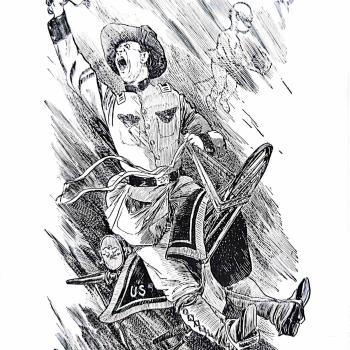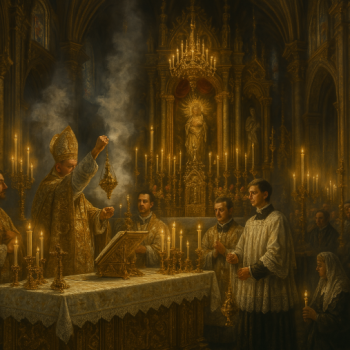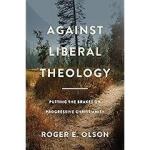Consider Paul's claim that "this slight momentary affliction is preparing for us an eternal weight of glory beyond all comparison, because
we look not to the things that are seen but to the things that are unseen; for the things that are seen are transient, but the things that are unseen are eternal" (2 Cor 4:17-18). Paul's emphasis on an "eternal weight of glory beyond all comparison" (or "beyond all measure") calls to mind the transcending of this-worldly limitations that Plato is known for evoking. When Paul tells the Corinthians that by "beholding the glory of the Lord" they are "being changed into his likeness from one degree of glory to another" (2 Cor 3:18), his expressions likewise resonate with Platonic and Stoic notions, without thereby ceasing to be uniquely Christian. Yet when N. T. Wright, whose opposition to Platonism we noted above, interprets 2 Corinthians 3-4, he finds that our "glory" means simply that we are not overcome by suffering, because we will be vindicated by God. In his view, the "glory of God" refers to the work of the Spirit in the hearts of believers. Christians are changed into Christ's likeness "from one degree of glory to another" when Christians "reflect God's glory to one another and so enable an honest and open-faced ministry to take place."41 It will be clear that Wright makes very little of the "eternal weight of glory beyond all comparison" that Paul promises us. But if Paul is right that our glory is to be "beyond all comparison," it may be that Wright overemphasizes the horizontal dimension of glory and underestimates its transcendent dimension.
An emphasis on the horizontal dimension also appears in Wright's portrait of resurrection life. He states, "There will be work to do and we shall relish doing it. All the skills and talents we have put to God's service in this present life . . . will be enhanced and ennobled and given back to us to be exercised to his glory."42 This description of the enhancement of our skills and talents does not evoke a life utterly "beyond all comparison." Wright imagines the new "work to do" not in terms of the "things that are unseen," but emphatically in terms of the things that are seen. The transcendent dimension found in Paul seems strongly muted in Wright. If we emphasize the renewed material creation and a new set of cosmic adventures, we risk turning eternal life into something quite banal.43 Who wants to repeat forever, no matter in how elevated a fashion, our earthly experiences of banqueting and evangelization?
• • •
How then to describe the hope of Christians without falling into an unhelpful dichotomy between the horizontal and the transcendent or
between biblical narrative and Greek philosophical culture? It seems to me that Thomas Aquinas can help us here. Rooted in Scripture, the Apostles' Creed, and the Fathers' insights, and benefiting from a critical appreciation of Greek philosophy, Aquinas' contemplation of the mysteries of faith generates rich insight into Jesus' passage and ours. We will explore Jesus' descent into hell, his resurrection, and his ascension to the right hand of the Father. Jesus enables the Church, as his eschatological people, to share in his passage by sending the Holy Spirit to sanctify us and to enable us to perform works of love. By tracing this path, I hope to gain insight into how Christians can appropriately speak about "the hope set before us" (Heb 6:18).
As we begin this study, then, let us pray with the psalmist: "You have said, 'Seek my face.' My heart says to you, 'Your face, Lord, do I seek'" (Ps 27:8). In the joys and trials of this life, "The Lord is the strength of his people, he is the saving refuge of his anointed. O save your people, and bless your heritage; be their shepherd, and carry them for ever" (Ps 28:8-9).131
Notes
Introduction
1 Richard B. Hays, "'Why Do You Stand Looking Up toward Heaven?' New Testament Eschatology at the Turn of the Millennium," Modern Theology 16 (2000): 133. See also Pope Benedict XVI, Light of the World: The Pope, the Church, and the Signs of the Times: A Conversation with Peter Seewald, trans. Michael J. Miller and Adrian J. Walker (San Francisco: Ignatius Press, 2010), 179: "Our preaching, our proclamation, really is one-sided, in that it is largely directed toward the creation of a better world, while hardly anyone talks any more about the other, truly better world."
2 Hays, "'Why Do You Stand Looking Up toward Heaven?,'" 133.
3 Anthony Godzieba, e.g., thinks that "current Roman Catholic eschatology is in disarray. The problems are rooted not only in the fact that the eschata are fundamentally mysteries that lay beyond any humanly achieved certainty. There are also major questions concerning the relative appropriateness of the images, language, and categories to be used for liturgical and personal prayer, for preaching, and for theological reflection upon eternal life. Crafting a contemporary eschatology has been made more difficult due to the demise of theology's traditional dualistic anthropology and by the fact that the theological discussion of 'personal identity' has lagged behind the contemporary philosophical discussions of subjectivity and alterity." Godzieba, "Bodies and Persons, Resurrected and Postmodern: Towards a Relational Eschatology," in Theology and Conversation: Towards a Relational Theology, ed. J. Haers and P. De Mey (Leuven: Leuven University Press, 2003), 211. Godzieba expresses concern that the 1970 revisions of the funeral liturgy removed references to "soul," and he seeks to provide a postmodern, nondualist account of "soul" as symbolizing "the intersubjectively sharable incarnated depth of the self" (224).




